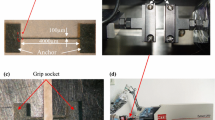Abstract
In this paper, we design a Z-type microspring, which consists of several “Z” type micromechanical beams within mutual connection. With good mechanical performance and mature LIGA fabrication technology, Ni is chosen as the material of Z-type MEMS microspring. The mechanical properties of electroformed Ni have been tested by the Micro Hardness Tester, and the Young’s modulus is 219 GPa. Different from traditional springs, microsprings can be divided into three application patterns in direction x, y, and z to study. Applying the Castigliano second theorem of energy method in macro theory, the formulas used to calculate the spring constant of Z-type microspring in the directions of the three application patterns were derived, and verified by the ANSYS finite element method. Using the Tytron250 micro force test machine, the experiments of the Z-type microspring deformation properties were carried out. The spring constant, rupture force and rupture strength of Z-type microspring in direction y are 3821 N/m, 1.64 N and 1.61 GPa, respectively. The experimental results agree with the theoretical analysis. Based on the analysis above, the change laws of the spring constant of microspring in the three application patterns are summarized.







Similar content being viewed by others
References
Saotome Y, Yokote S, Okamoto T et al (2003) Design and in-situ mechanical testing system for probe card/UV-LIGA-Ni microspring. In: Proceedings IEEE sixteenth annual international conference on micro electro mechanical systems, pp 670–673
Vujanic A, Adamovic N, Jakovljevic M et al (2000) Silicon microstructure for precise measurements of mechanicalmoments. In: 22nd international conference on microelectronics proceedings, pp 565–568
Di Chen, Lei Shi, Jun Zhu et al (2003) Simulation, fabrication and characterization of planar microsprings. Microfabr Technol 7(8):57–60
Seto MW, Robbie K, Brett MJ et al (1999) Mechanical properties of microspring thin films fabricated by glancing angle deposition (GLAD). In: Engineering solutions for the next millennium. 1999 IEEE Canadian conference on electrical and computer engineering, pp 1616–1620
Brenner W, Haddad GH, Rennhofer H (2000) New types of silicon torsion microspring and their characterization. In: Proceedings of SPIE-design, test, integration, and packaging of MEMS/MOEMS, pp 462–470
Awaja N, Sood DK (2005). Modeling and simulation of a flat spring for use in an electromagnetic microgenerator. In: Proceedings of SPIE-smart structures, devices, and systems II, pp 361–372
Lijie Li, Uttamchandani DG (2002) Analysis of microsprings for calculating the force produced by microactuators. In: Proceedings of SPIE-design, test, integration, and packaging of MEMS/MOEMS, pp 394–402
Robinson CH, Wood RH, Hoang TW (2002) Development of inexpensive, ultra-miniature MEMS-based safety and arming (S&A) device for small-caliber munition fuzes. US Army Tank Automotive Command (TACOM) Armament Research Development and Engineering Center Fuze Division
BoYuan Y (2002) Mechanics of material (I). China Machine Press, Beijing
Cho HS, Hemker KJ, Lian K et al (2002) Tensile, creep and fatigue properties of LIGA Nickel structures. In: The fifteenth IEEE international conference on micro electro mechanical systems, pp 439–442
Majjad H, Basrour S, Delobelle P, Schmidt M (1999) Dynamic determination of Young’s modulus of electroplated nickel used in LIGA technique. Sens Actuator 74:148–151
Acknowledgments
This work was supported by a grant from the national defense key laboratory (No. 514850301). The author would also thank Yi fu-ting from the Institute of High Energy Physics (IHEP) of Chinese Academy of Sciences (CAS) in Beijing for fabricating the MEMS LIGA Ni microspring.
Author information
Authors and Affiliations
Corresponding author
Rights and permissions
About this article
Cite this article
Li, H., Gengchen, S. Analysis of application patterns of Z-type MEMS microspring. Microsyst Technol 15, 527–533 (2009). https://doi.org/10.1007/s00542-008-0758-1
Received:
Accepted:
Published:
Issue Date:
DOI: https://doi.org/10.1007/s00542-008-0758-1




